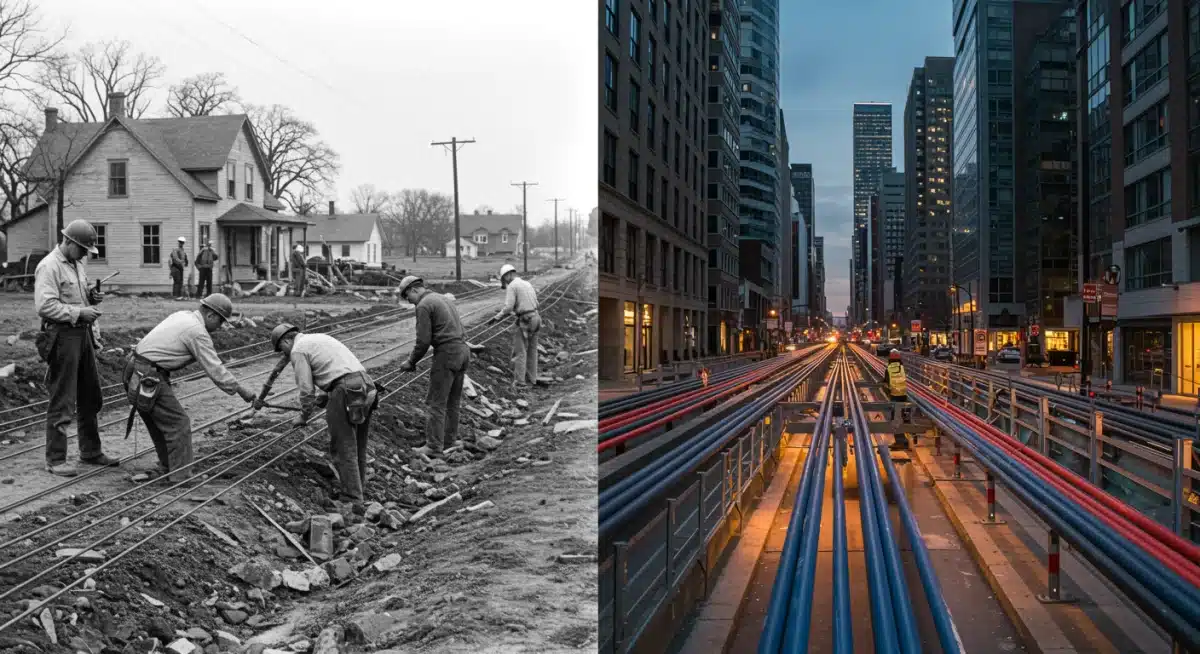Post-WWII Boom’s Impact on US Infrastructure & Connectivity

The post-WWII economic boom significantly influenced the development of US infrastructure and connectivity, establishing foundational networks while simultaneously creating long-term challenges in maintenance, funding, and equitable access.
How did the Post-WWII US Infrastructure boom profoundly shape the nation we inhabit today? The period following World War II ushered in an era of unprecedented economic growth, fundamentally altering the landscape and laying the groundwork for both America’s successes and its enduring challenges in connectivity.
The Genesis of Modern American Infrastructure
The conclusion of World War II ignited a remarkable period of prosperity in the United States, often referred to as the Golden Age of Capitalism. This economic boom, fueled by returning soldiers reintegrating into the workforce, burgeoning industries, and a widespread sense of optimism, directly translated into massive investments in the nation’s physical backbone. The federal government, along with state and local entities, embarked on ambitious projects designed to modernize and expand infrastructure, recognizing its critical role in sustained economic growth and national security.
This era saw the birth of monumental projects that would define American life for decades. The Interstate Highway System, initiated under President Eisenhower, stands as a prime example. Conceived for both defense and commerce, this vast network of roads facilitated unparalleled mobility, connecting cities and fostering suburbanization. Beyond highways, significant investments were made in expanding utility grids, water systems, and public works, all designed to support a rapidly growing population and an industrial powerhouse.
Key Drivers of Post-War Infrastructure Investment
- Economic Prosperity: A booming economy provided the capital and political will for large-scale public spending.
- Population Growth: The ‘baby boom’ and increased immigration necessitated new housing, schools, and urban services.
- National Security Concerns: The Cold War spurred investments in infrastructure deemed vital for military movement and defense.
- Technological Advancements: Innovations in construction techniques and materials made large-scale projects more feasible.
The Rise of Connectivity: Communications and Utilities
Beyond physical transportation, the post-WWII era also marked a pivotal moment for connectivity in broader terms. The expansion of telephone networks, electrification, and nascent broadcast media began to weave a tighter social and economic fabric across the nation. This period saw a dramatic increase in household access to these essential services, transforming daily life and commerce.
Telephone companies, often regional monopolies, rapidly expanded their lines, making long-distance communication more accessible and affordable. Electrification, while already underway, reached its peak, bringing power to almost every corner of the country and enabling the widespread adoption of new appliances and industrial machinery. These foundational investments in communication and utility networks were crucial, setting precedents for how future connectivity challenges would be approached.
The mindset was largely one of universal service and broad access, driven by a belief that these services were fundamental to modern citizenship and economic participation. While the technology was analog, the underlying principles of connecting people and places across vast distances were firmly established, influencing subsequent generations of infrastructure development.
The Interstate Highway System: A Double-Edged Legacy
The Federal-Aid Highway Act of 1956, which authorized the construction of the Interstate Highway System, represents perhaps the most iconic legacy of the post-WWII infrastructure boom. This ambitious project, spanning over 40,000 miles, dramatically reshaped American geography, economy, and culture. It facilitated efficient freight transportation, boosted the automotive industry, and enabled the rise of suburban communities.
However, the very success of the Interstate System also sowed the seeds for future challenges. Its construction often came at the expense of established urban neighborhoods, displacing communities and exacerbating racial and economic segregation. Furthermore, the system’s focus on individual vehicle travel led to a decline in public transit investment, contributing to today’s traffic congestion, pollution, and reliance on fossil fuels. The sheer scale of the system also created an immense maintenance burden, a challenge that continues to plague states and the federal government decades later.
Unintended Consequences of Highway Expansion
- Urban Decay: Highways often cut through and isolated minority neighborhoods, accelerating decline.
- Increased Sprawl: Facilitated the growth of suburbs and car-dependent lifestyles, increasing commute times.
- Environmental Impact: Contributed to air pollution, greenhouse gas emissions, and habitat fragmentation.
- Maintenance Backlog: The vast network requires continuous, costly upkeep, leading to deferred maintenance issues.
Emerging Connectivity Gaps: A Post-Boom Reality
While the post-WWII era laid a robust foundation for physical infrastructure and analog communication, it did not anticipate the digital revolution. Today, the very systems designed for mid-20th-century needs often struggle to support 21st-century demands, particularly in digital connectivity. The initial investments prioritized broad, but not necessarily deep, coverage, often leaving rural and economically disadvantaged areas with inferior or non-existent access to high-speed internet.
This has created a significant digital divide, where access to education, healthcare, and economic opportunities is increasingly contingent on reliable broadband. The infrastructure built decades ago, from telephone poles to underground conduits, was not designed for the bandwidth requirements of fiber optics or 5G wireless. Retrofitting or replacing these systems presents an enormous financial and logistical challenge, highlighting a direct consequence of the historical focus on different technological paradigms.
The rapid evolution of technology has exposed the limitations of a ‘build it and they will come’ approach, revealing that continuous, adaptive investment is crucial. The historical emphasis on ‘hard’ infrastructure like roads and bridges often overshadowed the less tangible, but equally vital, ‘soft’ infrastructure of information networks.

Funding Models: From Post-War Certainty to Modern Uncertainty
The post-WWII infrastructure boom was largely funded through a combination of federal initiatives, state bonds, and a robust tax base fueled by economic growth. The Interstate Highway System, for instance, was primarily financed by the Highway Trust Fund, supported by gasoline taxes. This model provided a relatively stable and predictable funding stream for large-scale projects.
However, this funding certainty has eroded over time. Gasoline tax revenues have stagnated due to more fuel-efficient vehicles and inflation, while the costs of maintaining and upgrading aging infrastructure have soared. Political polarization and competing priorities have made it increasingly difficult to secure consistent, long-term funding for infrastructure projects at the federal level. This shift from a period of abundant resources and political consensus to one of fiscal constraint and partisan gridlock is a critical factor in understanding current infrastructure challenges.
The initial investments were made during a unique economic period that may not be replicable. Learning from the successes and failures of post-war funding models is essential for developing sustainable strategies for today’s infrastructure needs, particularly as new technologies like electric vehicles change traditional revenue streams.
Addressing Legacy Challenges in the 21st Century
Today, the United States grapples with a formidable challenge: how to modernize and expand its infrastructure and connectivity while simultaneously addressing the legacy issues inherited from the post-WWII boom. This includes repairing crumbling roads and bridges, upgrading outdated water systems, and, critically, extending high-speed internet to every household.
Current efforts, such as the Bipartisan Infrastructure Law, represent a renewed commitment to infrastructure investment, echoing the ambition of the post-war era. However, the context is vastly different. The focus is not just on building new, but also on repairing, replacing, and ensuring equitable access. There is a greater emphasis on sustainability, resilience to climate change, and leveraging digital technologies to create ‘smart’ infrastructure.
The goal is to bridge the gap between the foundational systems of the past and the advanced requirements of the future, ensuring that no community is left behind in the digital age. This involves innovative financing, public-private partnerships, and a long-term vision that transcends political cycles.
The Path Forward: Learning from History
Understanding How the Post-WWII US Infrastructure boom profoundly shaped current challenges is crucial for charting a successful path forward. The era demonstrated the power of concerted national effort and investment in driving economic prosperity and improving quality of life. Yet, it also revealed the complexities of long-term planning, the potential for unintended consequences, and the importance of adapting to technological change.
Today’s infrastructure decisions must balance the need for immediate repairs with the imperative to build for the future. This means not only investing in physical assets but also in the digital networks that are now fundamental to modern society. It requires a holistic approach that considers environmental impact, social equity, and economic competitiveness.
The lessons from the post-war period highlight that infrastructure is never truly ‘finished.’ It requires continuous attention, strategic investment, and a willingness to evolve. The current generation faces the task of reimagining and rebuilding, drawing on the historical blueprint while correcting its shortcomings, to ensure a resilient and connected future for all Americans.
| Key Aspect | Impact on Current US Infrastructure |
|---|---|
| Highway Expansion | Created vast transportation networks but led to urban decay, sprawl, and significant maintenance backlogs today. |
| Early Connectivity | Established widespread telephone and electricity grids, but not designed for modern digital demands, creating current broadband gaps. |
| Funding Models | Relied on robust tax bases and gas taxes, now insufficient due to economic shifts and fuel efficiency, causing funding shortfalls. |
| Policy Focus | Prioritized physical, large-scale projects, overlooking future digital needs and equity, contributing to today’s infrastructure disparity debates. |
Frequently Asked Questions About Post-WWII Infrastructure
The post-WWII economic boom, fueled by returning soldiers, industrial expansion, and a strong national economy, was the primary driver. This prosperity provided the necessary capital and political will for massive public works projects, aiming to support a growing population and enhance national security.
The Interstate Highway System dramatically reshaped US cities, facilitating suburban growth but often displacing urban communities and contributing to racial segregation. While it improved transportation efficiency, it also led to decreased public transit investment and increased car dependency.
The primary lasting challenge is the digital divide. While the post-WWII era expanded analog communication, it didn’t anticipate high-speed internet needs. Rural and underserved areas often lack modern broadband, stemming from initial infrastructure designs not built for digital demands.
Post-war funding was stable, largely from gas taxes and a robust economy. Today, gas tax revenues have declined due to fuel efficiency, and political consensus for large-scale, consistent funding is more elusive. This shift has created significant maintenance and upgrade funding gaps.
Lessons include the importance of continuous investment, adapting to technological change, and considering long-term societal impacts. While the boom showed the power of national projects, it also highlighted the need for equitable planning and sustainable funding models for future infrastructure.
Looking Ahead
The legacy of the post-WWII economic boom continues to shape today’s infrastructure and connectivity landscape. As the nation confronts aging systems and the imperative of universal digital access, understanding this historical context is paramount. The current push for infrastructure renewal, exemplified by recent legislative efforts, signifies a critical juncture. It underscores a collective recognition that past successes, while monumental, also created enduring challenges that now demand innovative solutions and sustained investment to secure America’s future competitiveness and societal well-being.





